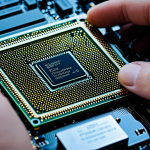Emerging Technologies Transforming the UK’s Internet Infrastructure
The UK internet infrastructure is undergoing significant shifts driven by emerging technologies that boost both speed and reliability. One critical area of development is the widespread deployment of fibre-optic networks, which vastly improve broadband capacity by transmitting data at the speed of light. This fibre rollout enhances connectivity in urban hubs and increasingly reaches rural locations, reducing the gap in internet quality across regions.
Simultaneously, the expansion of 5G technology is revolutionizing the landscape by delivering low latency and high bandwidth wireless connections. 5G supports a greater number of devices and enables advanced applications such as real-time streaming and complex IoT systems. This synergy between fibre-optic and 5G ensures more resilient and scalable internet services across the UK.
Additional reading : How Are Emerging Technologies Shaping the Future of Internet Connectivity in the UK?
Together, these broadband advancements represent a leap forward for the UK’s internet development, enabling smarter cities and enhanced digital services. Integration efforts focus on combining these technologies to maintain robust coverage regardless of geographic challenges, addressing both urban density and rural remoteness with tailored connectivity solutions that fit diverse users’ needs.
Emerging Technologies Transforming the UK’s Internet Infrastructure
The UK internet infrastructure is undergoing significant transformation, driven by advances in emerging technologies that promise faster, more reliable connectivity. Recent improvements have focused on expanding high-speed connections through increased deployment of fibre-optic cables, which now underpin much of the country’s broadband network. This shift from traditional copper lines allows for dramatically higher data transmission rates, crucial for supporting growing digital demands.
In parallel : How Can UK Companies Improve Their Digital Infrastructure?
The expansion of 5G networks is another key factor revolutionizing internet development. 5G offers improved speed, reduced latency, and enhanced capacity compared to previous mobile technologies. Its rollout is strategically blending with fibre-optic networks to provide seamless connectivity across both urban and rural areas. This integration is essential to reduce the digital divide and ensure consistent access.
Next-generation connectivity solutions are being tailored to address geographic challenges across the UK. For example, in rural locations where fibre deployment can be costly, 5G and fixed wireless access provide practical alternatives. This multifaceted approach exemplifies how emerging technologies are central to upgrading the UK’s internet infrastructure and meeting future broadband advancement goals.
Emerging Technologies Transforming the UK’s Internet Infrastructure
The UK’s internet development has accelerated significantly due to various emerging technologies reshaping the UK internet infrastructure. Beyond the well-known fibre-optic and 5G advancements, integration efforts increasingly focus on incorporating next-generation connectivity solutions tailored to both urban and rural needs. The key lies in creating a seamless network environment that blends fixed and wireless technologies to overcome geographic and demographic challenges.
In urban areas, these broadband advancements enable dense device connections, supporting smart city frameworks with IoT and real-time data services. Meanwhile, rural settings benefit from a targeted deployment of flexible technologies like fixed wireless access, enhancing coverage where laying fibre is impractical. The synergy of these technologies ensures that the infrastructure is both scalable and resilient.
Moreover, ongoing innovations such as network function virtualization and software-defined networking improve the management and efficiency of the UK internet infrastructure. By dynamically allocating resources and optimizing traffic routes, these technologies elevate overall network performance. This multi-layered approach to enhancing UK internet infrastructure is crucial for sustaining growth and meeting future digital demands across the country.
Emerging Technologies Transforming the UK’s Internet Infrastructure
Building on fibre-optic and 5G advances, emerging technologies are reshaping the UK internet infrastructure for greater efficiency and coverage. Beyond pure hardware improvements, innovations in network management and software-defined networking optimize traffic flow and reduce downtime. These technologies enable dynamic allocation of bandwidth, crucial for meeting fluctuating demand across urban and rural areas.
Moreover, broadband advancements now incorporate edge computing, which processes data closer to the user, lowering latency and enhancing responsiveness. This is vital for applications like augmented reality and real-time analytics, driving the internet development toward more interactive and intelligent services.
Integration of these next-generation connectivity solutions facilitates tailored approaches for diverse settings. In dense cities, high-capacity fibre and 5G mesh with smart infrastructure, supporting IoT devices and seamless digital experiences. Rural regions benefit from hybrid models combining fixed wireless access with fibre, ensuring cost-effective yet reliable service.
Together, these emerging technologies not only improve speed and reliability but also bolster the adaptability and sustainability of the UK’s internet framework, positioning it strongly for future digital demands.
Emerging Technologies Transforming the UK’s Internet Infrastructure
The UK internet infrastructure continues evolving with significant contributions from emerging technologies such as fibre-optic networks and 5G, but the integration of next-generation connectivity is equally pivotal. These technologies form the backbone of current broadband advancements and address unique urban and rural challenges effectively.
In urban environments, dense populations and high device counts require networks that can manage heavy traffic with minimal latency. Here, fibre-optic deployments combine with 5G to ensure seamless, fast connections supporting applications in smart cities, healthcare, and business. Advanced wireless solutions like fixed wireless access extend coverage, especially in areas where fibre may not be viable.
In rural regions, the focus remains on overcoming geographic obstacles. Combining fibre and wireless technologies—tailored to local needs—helps reduce the digital gap and fosters inclusive internet development. This hybrid approach optimizes resource allocation and delivers reliable connectivity, crucial for education, remote work, and public services.
Ultimately, the UK’s evolving internet infrastructure showcases how integrating diverse emerging technologies produces scalable networks. This strategy supports continuous broadband advancements and forms the foundation for the country’s growing digital economy.
Emerging Technologies Transforming the UK’s Internet Infrastructure
The UK internet infrastructure is evolving through strategic deployment of emerging technologies that enhance network capacity and resilience. Recent broadband advancements focus on expanding fibre-optic networks and 5G coverage, but the integration of next-generation connectivity solutions is equally crucial. These solutions combine fixed and wireless technologies to address diverse geographic challenges across the UK.
In urban areas, these emerging technologies support high-density device connectivity, enabling smart city initiatives that rely on real-time data and IoT integration. Conversely, rural regions benefit from hybrid models combining fibre-optic with fixed wireless access, delivering cost-effective, reliable internet where fibre deployment alone is impractical.
Key to this infrastructural evolution is the dynamic orchestration of resources through software-defined networking and network function virtualization. These tools optimize traffic flow and bandwidth allocation, ensuring consistent performance amid fluctuating demand. As a result, the UK internet infrastructure becomes more adaptable and scalable, supporting comprehensive internet development that bridges gaps between urban and rural connectivity.
This multi-faceted approach to upgrading the UK’s internet ecosystem exemplifies how broadband advancements and emerging technologies synergize to provide robust, future-ready digital infrastructure.
Emerging Technologies Transforming the UK’s Internet Infrastructure
The current UK internet infrastructure benefits significantly from ongoing broadband advancements centered on the expansion of fibre-optic networks and 5G technology. Fibre-optic cables deliver unparalleled speed and stability by transmitting data using light pulses, vastly surpassing traditional copper connections. This infrastructure enhancement reduces latency and increases bandwidth, ensuring the network can handle growing demand effectively.
Simultaneously, the rollout of 5G extends high-speed, low-latency connections wirelessly, especially critical in areas where fibre deployment is challenging. The integration of emerging technologies like 5G with fibre provides a hybrid connectivity model tailored to both urban and rural environments. In cities, this results in reliable connections that support smart infrastructure and dense IoT ecosystems. Meanwhile, rural regions gain affordable access through fixed wireless access that leverages 5G and existing fibre where feasible.
Next-generation connectivity solutions use software-defined networking and virtualization for dynamic traffic management, optimizing network load and improving fault tolerance. These combined broadband advancements position the UK’s internet infrastructure to meet future digital demands while fostering inclusive internet development. The strategic integration accommodates geographic and demographic diversity, making connectivity more resilient and scalable nationwide.
Emerging Technologies Transforming the UK’s Internet Infrastructure
The UK internet infrastructure continues to evolve rapidly, underpinned by crucial broadband advancements that combine fibre-optic deployments with expanding 5G coverage. This strategic integration supports a dynamic and scalable network structure, addressing diverse connectivity needs across urban and rural landscapes.
In urban areas, high device density demands networks capable of managing intense traffic with minimal latency. Here, emerging technologies like software-defined networking optimize bandwidth allocation, ensuring seamless performance. Fibre-optic cables serve as a backbone while 5G layers provide flexible and fast wireless access, facilitating advanced applications in smart city development and real-time data exchange.
Conversely, in rural regions, geographic constraints and cost challenges limit fibre rollout. To combat this, next-generation connectivity solutions such as fixed wireless access leverage 5G and other wireless technologies to bridge the digital divide. This hybrid approach enhances internet development by delivering reliable, high-speed connections tailored to local conditions.
Together, these broadband advancements showcase the UK’s commitment to creating a resilient, inclusive internet infrastructure that harnesses multiple emerging technologies to meet present and future digital demands effectively.
Emerging Technologies Transforming the UK’s Internet Infrastructure
The UK internet infrastructure continues to evolve through the integration of emerging technologies that drive substantial broadband advancements. Central to this progress is the combined expansion of fibre-optic deployments and 5G networks, forming a hybrid approach that enhances connectivity across diverse settings. Fibre-optic cables provide ultra-high-speed data transmission, dramatically reducing latency and boosting bandwidth—an essential foundation for modern internet development.
Simultaneously, the spread of 5G technology complements fibre by offering flexible wireless solutions, particularly valuable in rural and hard-to-reach areas where laying fibre is costly. This synergy enhances resilient coverage, enabling seamless connectivity essential for urban and rural users alike.
Integration of next-generation connectivity solutions extends beyond physical infrastructure to include software innovations like network function virtualization. These enable dynamic resource allocation and traffic management, optimizing network performance amid fluctuating demands. As a result, broadband advancements are not only increasing speed but improving efficiency and scalability.
Collectively, these emerging technologies transform the UK internet infrastructure, underpinning ongoing internet development that balances high-capacity urban needs with tailored rural services. This comprehensive approach positions the UK for sustained digital growth and inclusivity.
Emerging Technologies Transforming the UK’s Internet Infrastructure
The UK internet infrastructure continues to evolve through significant broadband advancements driven by the expansion of fibre-optic networks and accelerated 5G deployment. These emerging technologies enhance capacity, speed, and reliability, forming the foundation for modern internet development. Fibre-optic cables provide the backbone with ultra-fast data transmission, while 5G extends high-speed, low-latency wireless connectivity that is critical in both urban and rural areas.
Integration of these technologies allows the UK to address geographic disparities effectively. In dense urban centers, the convergence of fibre and 5G supports smart city infrastructure, handling massive device connectivity and real-time data exchange. Conversely, rural regions benefit from hybrid models that combine fibre with fixed wireless access enabled by 5G, ensuring cost-effective yet robust connectivity where fibre alone is not feasible.
Next-generation connectivity solutions also incorporate intelligent network management tools such as software-defined networking. These tools dynamically allocate bandwidth and optimize traffic flow, maintaining performance amid fluctuating demand. Collectively, these broadband advancements and emerging technologies create an adaptable, scalable, and resilient framework essential for ongoing internet development across the UK.
Emerging Technologies Transforming the UK’s Internet Infrastructure
The UK internet infrastructure has seen rapid evolution, propelled by key broadband advancements such as the expansion of fibre-optic networks and the rollout of 5G technology. These emerging technologies work in tandem to enhance capacity, speed, and reliability across diverse regions. Fibre-optic deployments provide ultra-high-speed data transmission with low latency, forming a robust foundation for modern internet development. Meanwhile, the expansion of 5G addresses coverage gaps by delivering flexible wireless connectivity, especially vital for rural areas where laying fibre is cost-prohibitive.
Integration of next-generation connectivity solutions optimizes this hybrid model by applying software-defined networking and network virtualization. These software layers dynamically manage bandwidth allocation and traffic flow to meet demand fluctuations efficiently. In urban settings, this synergy supports high device densities and advanced applications such as smart city frameworks and real-time data services. Conversely, rural locales benefit from fixed wireless access technologies that bridge connectivity divides by complementing existing fibre and 5G networks.
This multi-dimensional approach to upgrading the UK internet infrastructure highlights how broadband advancements and emerging technologies collectively enable scalable, resilient networks tailored to the country’s geographic and demographic challenges.


